Analysis of Corruption and Business Ethics in Nepal: Recommendations
VerifiedAdded on 2023/06/05
|11
|2192
|144
Report
AI Summary
This report examines the pervasive issue of corruption in Nepal, which has significantly impacted business ethics and performance. The study explores various forms of corruption, including bribery, embezzlement, extortion, favoritism, and nepotism, and their detrimental effects on financial stability, stakeholder trust, and investor confidence. The analysis highlights the government's strategies to combat corruption, such as increased transparency, the establishment of international conventions, and the use of smart technology. Furthermore, the report provides key recommendations to reduce corruption, including improving education, changing governmental regulations, and lowering inflation rates. The conclusion emphasizes the need for comprehensive measures to minimize corruption and enhance business profitability in Nepal.
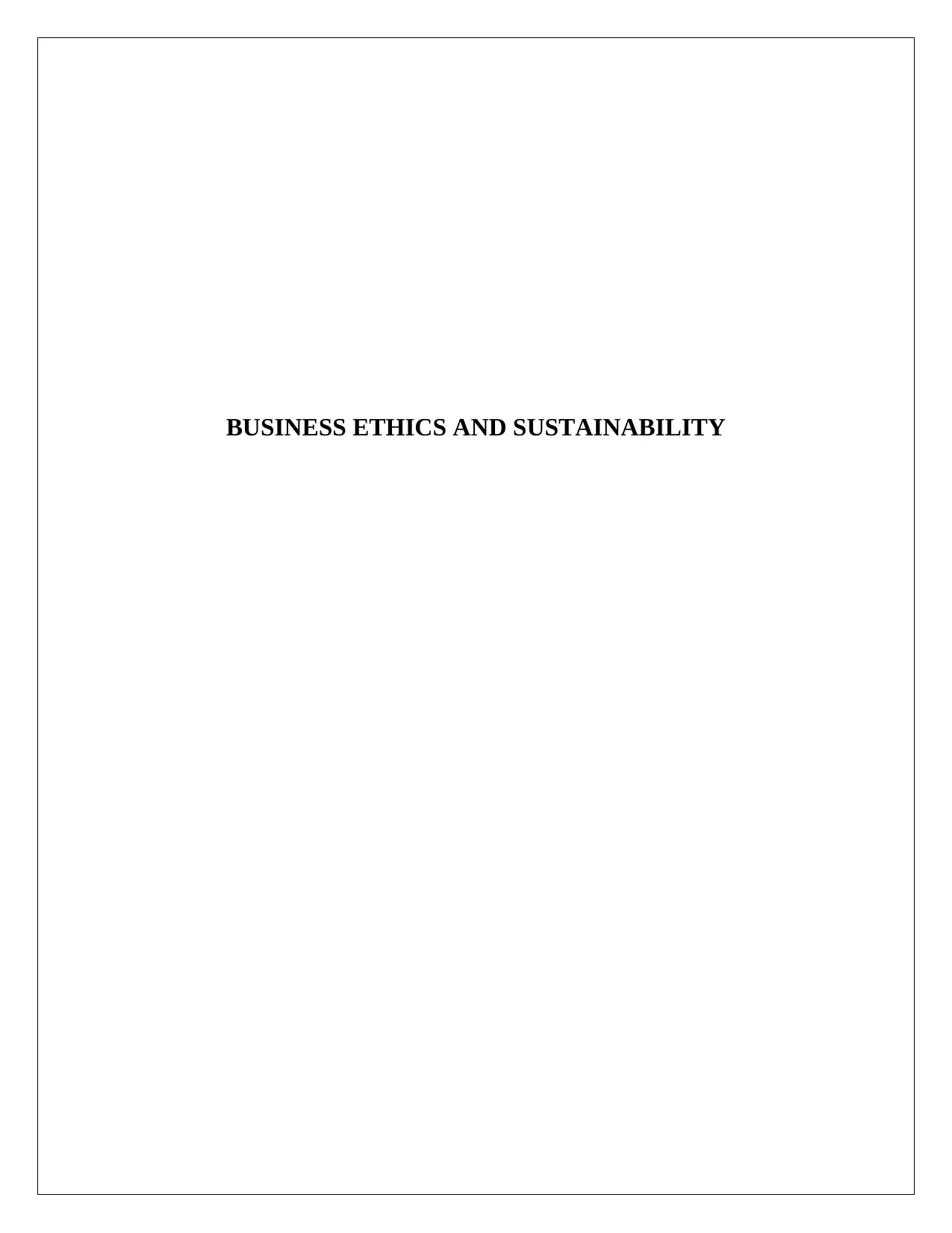
BUSINESS ETHICS AND SUSTAINABILITY
Paraphrase This Document
Need a fresh take? Get an instant paraphrase of this document with our AI Paraphraser
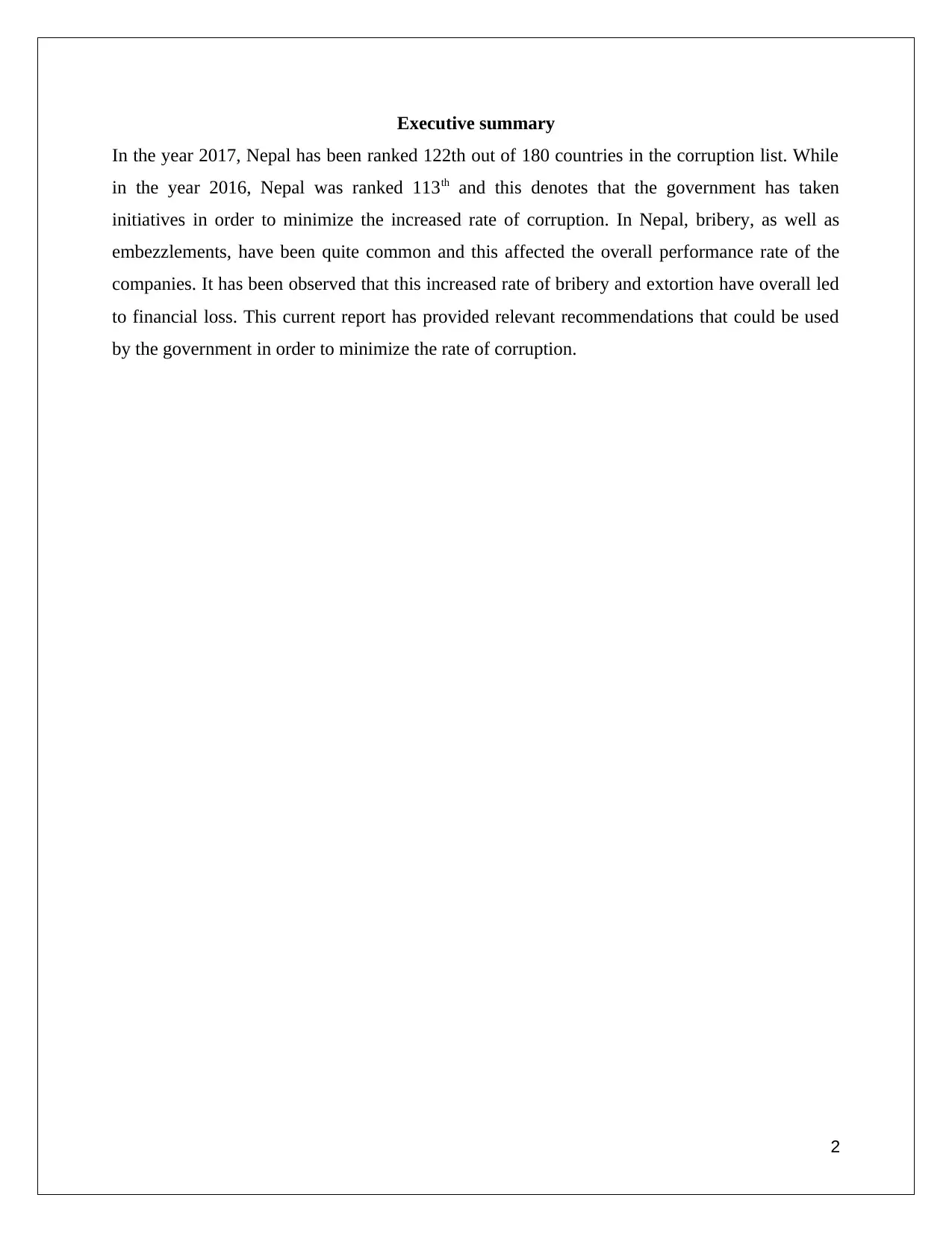
Executive summary
In the year 2017, Nepal has been ranked 122th out of 180 countries in the corruption list. While
in the year 2016, Nepal was ranked 113th and this denotes that the government has taken
initiatives in order to minimize the increased rate of corruption. In Nepal, bribery, as well as
embezzlements, have been quite common and this affected the overall performance rate of the
companies. It has been observed that this increased rate of bribery and extortion have overall led
to financial loss. This current report has provided relevant recommendations that could be used
by the government in order to minimize the rate of corruption.
2
In the year 2017, Nepal has been ranked 122th out of 180 countries in the corruption list. While
in the year 2016, Nepal was ranked 113th and this denotes that the government has taken
initiatives in order to minimize the increased rate of corruption. In Nepal, bribery, as well as
embezzlements, have been quite common and this affected the overall performance rate of the
companies. It has been observed that this increased rate of bribery and extortion have overall led
to financial loss. This current report has provided relevant recommendations that could be used
by the government in order to minimize the rate of corruption.
2
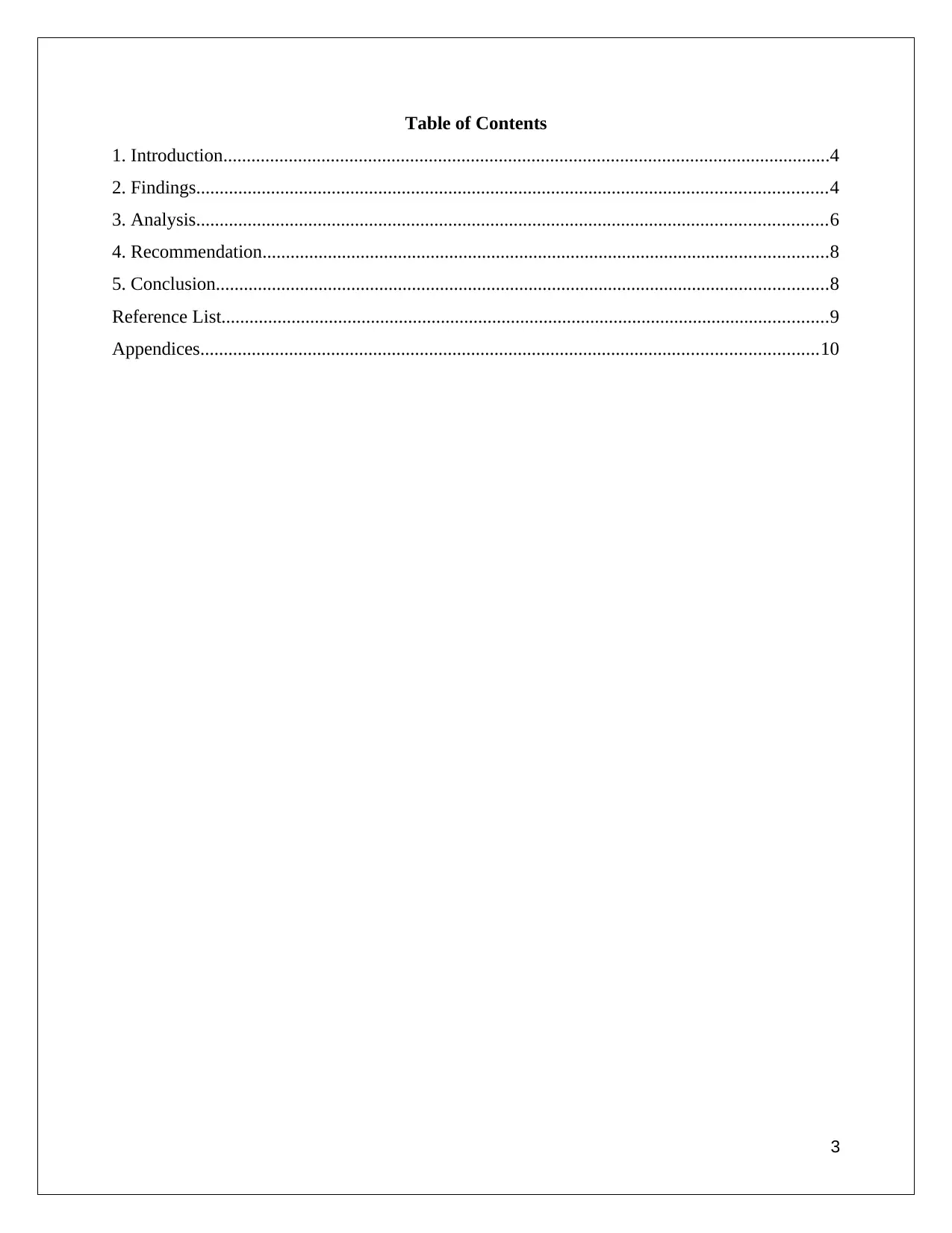
Table of Contents
1. Introduction..................................................................................................................................4
2. Findings.......................................................................................................................................4
3. Analysis.......................................................................................................................................6
4. Recommendation.........................................................................................................................8
5. Conclusion...................................................................................................................................8
Reference List..................................................................................................................................9
Appendices....................................................................................................................................10
3
1. Introduction..................................................................................................................................4
2. Findings.......................................................................................................................................4
3. Analysis.......................................................................................................................................6
4. Recommendation.........................................................................................................................8
5. Conclusion...................................................................................................................................8
Reference List..................................................................................................................................9
Appendices....................................................................................................................................10
3
⊘ This is a preview!⊘
Do you want full access?
Subscribe today to unlock all pages.

Trusted by 1+ million students worldwide
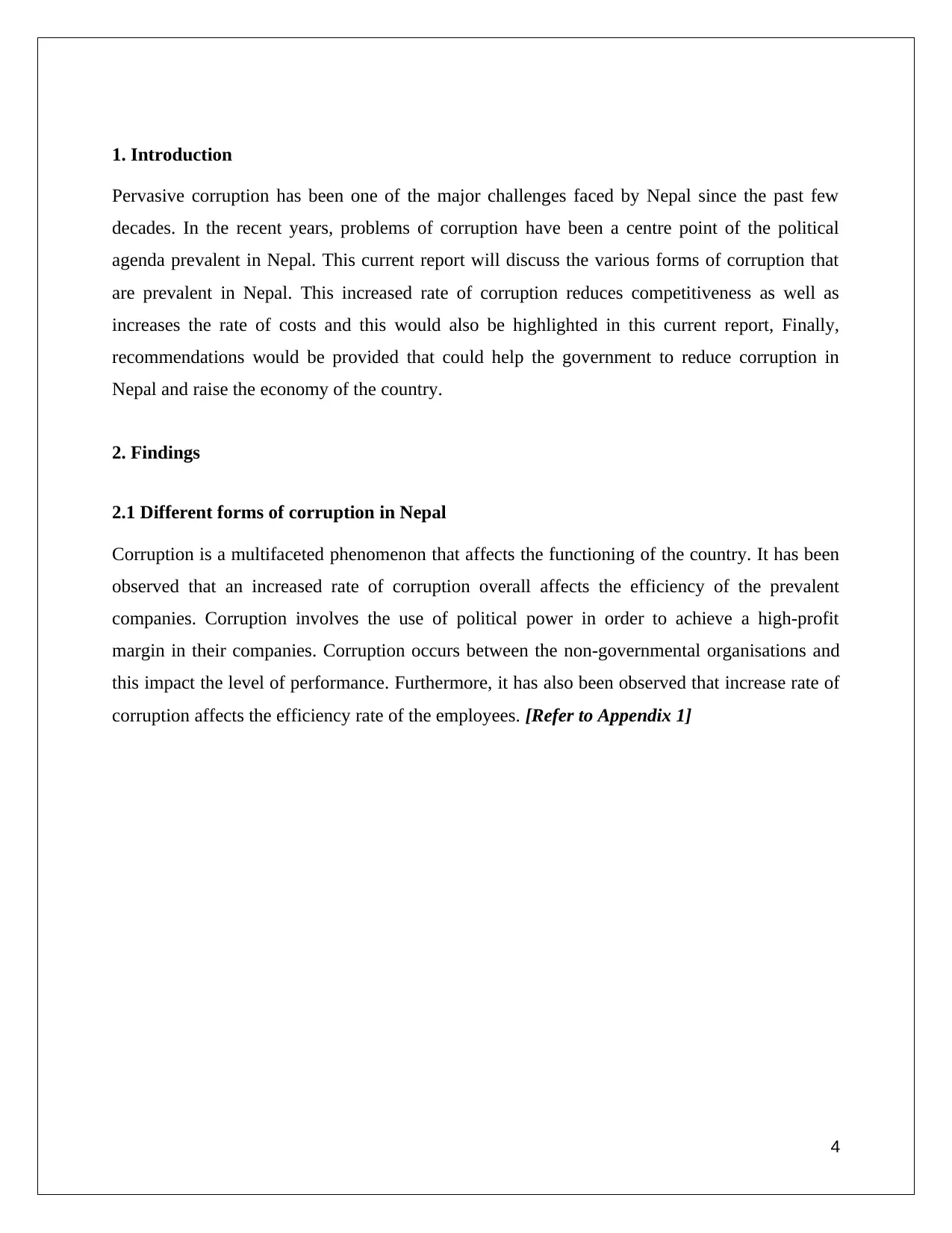
1. Introduction
Pervasive corruption has been one of the major challenges faced by Nepal since the past few
decades. In the recent years, problems of corruption have been a centre point of the political
agenda prevalent in Nepal. This current report will discuss the various forms of corruption that
are prevalent in Nepal. This increased rate of corruption reduces competitiveness as well as
increases the rate of costs and this would also be highlighted in this current report, Finally,
recommendations would be provided that could help the government to reduce corruption in
Nepal and raise the economy of the country.
2. Findings
2.1 Different forms of corruption in Nepal
Corruption is a multifaceted phenomenon that affects the functioning of the country. It has been
observed that an increased rate of corruption overall affects the efficiency of the prevalent
companies. Corruption involves the use of political power in order to achieve a high-profit
margin in their companies. Corruption occurs between the non-governmental organisations and
this impact the level of performance. Furthermore, it has also been observed that increase rate of
corruption affects the efficiency rate of the employees. [Refer to Appendix 1]
4
Pervasive corruption has been one of the major challenges faced by Nepal since the past few
decades. In the recent years, problems of corruption have been a centre point of the political
agenda prevalent in Nepal. This current report will discuss the various forms of corruption that
are prevalent in Nepal. This increased rate of corruption reduces competitiveness as well as
increases the rate of costs and this would also be highlighted in this current report, Finally,
recommendations would be provided that could help the government to reduce corruption in
Nepal and raise the economy of the country.
2. Findings
2.1 Different forms of corruption in Nepal
Corruption is a multifaceted phenomenon that affects the functioning of the country. It has been
observed that an increased rate of corruption overall affects the efficiency of the prevalent
companies. Corruption involves the use of political power in order to achieve a high-profit
margin in their companies. Corruption occurs between the non-governmental organisations and
this impact the level of performance. Furthermore, it has also been observed that increase rate of
corruption affects the efficiency rate of the employees. [Refer to Appendix 1]
4
Paraphrase This Document
Need a fresh take? Get an instant paraphrase of this document with our AI Paraphraser
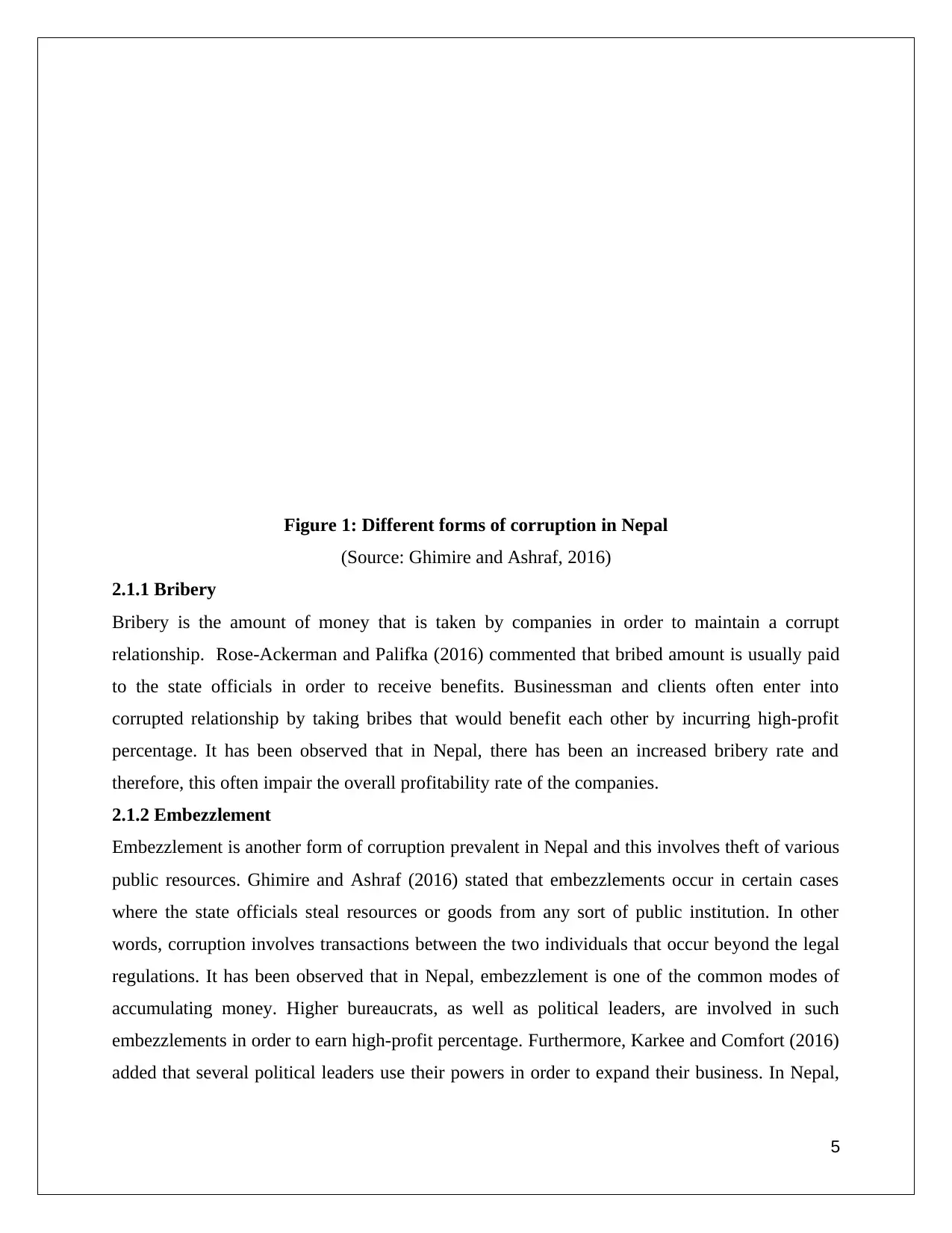
Figure 1: Different forms of corruption in Nepal
(Source: Ghimire and Ashraf, 2016)
2.1.1 Bribery
Bribery is the amount of money that is taken by companies in order to maintain a corrupt
relationship. Rose-Ackerman and Palifka (2016) commented that bribed amount is usually paid
to the state officials in order to receive benefits. Businessman and clients often enter into
corrupted relationship by taking bribes that would benefit each other by incurring high-profit
percentage. It has been observed that in Nepal, there has been an increased bribery rate and
therefore, this often impair the overall profitability rate of the companies.
2.1.2 Embezzlement
Embezzlement is another form of corruption prevalent in Nepal and this involves theft of various
public resources. Ghimire and Ashraf (2016) stated that embezzlements occur in certain cases
where the state officials steal resources or goods from any sort of public institution. In other
words, corruption involves transactions between the two individuals that occur beyond the legal
regulations. It has been observed that in Nepal, embezzlement is one of the common modes of
accumulating money. Higher bureaucrats, as well as political leaders, are involved in such
embezzlements in order to earn high-profit percentage. Furthermore, Karkee and Comfort (2016)
added that several political leaders use their powers in order to expand their business. In Nepal,
5
BriberyEmbezzlementExtortionFavoritismNepotism
(Source: Ghimire and Ashraf, 2016)
2.1.1 Bribery
Bribery is the amount of money that is taken by companies in order to maintain a corrupt
relationship. Rose-Ackerman and Palifka (2016) commented that bribed amount is usually paid
to the state officials in order to receive benefits. Businessman and clients often enter into
corrupted relationship by taking bribes that would benefit each other by incurring high-profit
percentage. It has been observed that in Nepal, there has been an increased bribery rate and
therefore, this often impair the overall profitability rate of the companies.
2.1.2 Embezzlement
Embezzlement is another form of corruption prevalent in Nepal and this involves theft of various
public resources. Ghimire and Ashraf (2016) stated that embezzlements occur in certain cases
where the state officials steal resources or goods from any sort of public institution. In other
words, corruption involves transactions between the two individuals that occur beyond the legal
regulations. It has been observed that in Nepal, embezzlement is one of the common modes of
accumulating money. Higher bureaucrats, as well as political leaders, are involved in such
embezzlements in order to earn high-profit percentage. Furthermore, Karkee and Comfort (2016)
added that several political leaders use their powers in order to expand their business. In Nepal,
5
BriberyEmbezzlementExtortionFavoritismNepotism
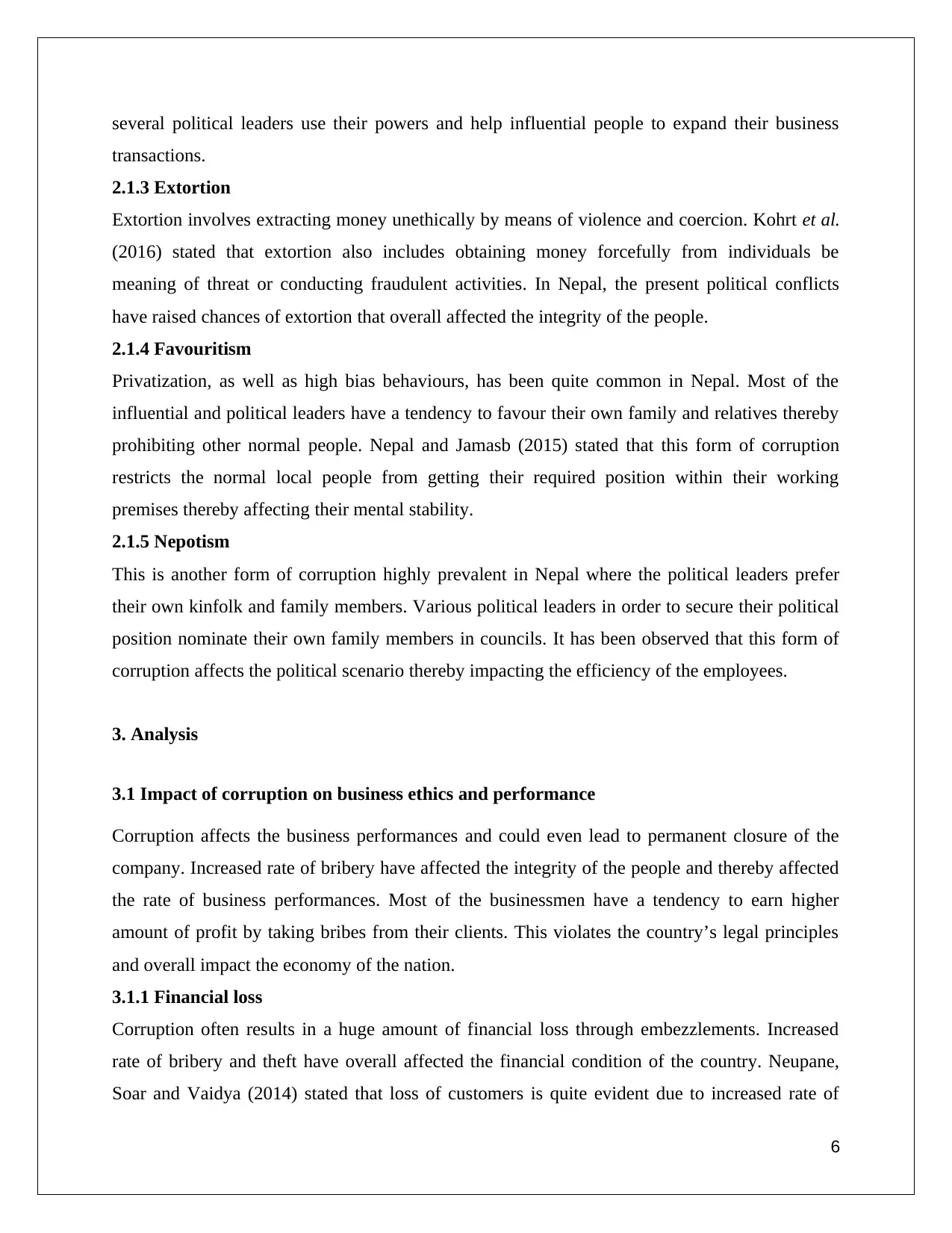
several political leaders use their powers and help influential people to expand their business
transactions.
2.1.3 Extortion
Extortion involves extracting money unethically by means of violence and coercion. Kohrt et al.
(2016) stated that extortion also includes obtaining money forcefully from individuals be
meaning of threat or conducting fraudulent activities. In Nepal, the present political conflicts
have raised chances of extortion that overall affected the integrity of the people.
2.1.4 Favouritism
Privatization, as well as high bias behaviours, has been quite common in Nepal. Most of the
influential and political leaders have a tendency to favour their own family and relatives thereby
prohibiting other normal people. Nepal and Jamasb (2015) stated that this form of corruption
restricts the normal local people from getting their required position within their working
premises thereby affecting their mental stability.
2.1.5 Nepotism
This is another form of corruption highly prevalent in Nepal where the political leaders prefer
their own kinfolk and family members. Various political leaders in order to secure their political
position nominate their own family members in councils. It has been observed that this form of
corruption affects the political scenario thereby impacting the efficiency of the employees.
3. Analysis
3.1 Impact of corruption on business ethics and performance
Corruption affects the business performances and could even lead to permanent closure of the
company. Increased rate of bribery have affected the integrity of the people and thereby affected
the rate of business performances. Most of the businessmen have a tendency to earn higher
amount of profit by taking bribes from their clients. This violates the country’s legal principles
and overall impact the economy of the nation.
3.1.1 Financial loss
Corruption often results in a huge amount of financial loss through embezzlements. Increased
rate of bribery and theft have overall affected the financial condition of the country. Neupane,
Soar and Vaidya (2014) stated that loss of customers is quite evident due to increased rate of
6
transactions.
2.1.3 Extortion
Extortion involves extracting money unethically by means of violence and coercion. Kohrt et al.
(2016) stated that extortion also includes obtaining money forcefully from individuals be
meaning of threat or conducting fraudulent activities. In Nepal, the present political conflicts
have raised chances of extortion that overall affected the integrity of the people.
2.1.4 Favouritism
Privatization, as well as high bias behaviours, has been quite common in Nepal. Most of the
influential and political leaders have a tendency to favour their own family and relatives thereby
prohibiting other normal people. Nepal and Jamasb (2015) stated that this form of corruption
restricts the normal local people from getting their required position within their working
premises thereby affecting their mental stability.
2.1.5 Nepotism
This is another form of corruption highly prevalent in Nepal where the political leaders prefer
their own kinfolk and family members. Various political leaders in order to secure their political
position nominate their own family members in councils. It has been observed that this form of
corruption affects the political scenario thereby impacting the efficiency of the employees.
3. Analysis
3.1 Impact of corruption on business ethics and performance
Corruption affects the business performances and could even lead to permanent closure of the
company. Increased rate of bribery have affected the integrity of the people and thereby affected
the rate of business performances. Most of the businessmen have a tendency to earn higher
amount of profit by taking bribes from their clients. This violates the country’s legal principles
and overall impact the economy of the nation.
3.1.1 Financial loss
Corruption often results in a huge amount of financial loss through embezzlements. Increased
rate of bribery and theft have overall affected the financial condition of the country. Neupane,
Soar and Vaidya (2014) stated that loss of customers is quite evident due to increased rate of
6
⊘ This is a preview!⊘
Do you want full access?
Subscribe today to unlock all pages.

Trusted by 1+ million students worldwide
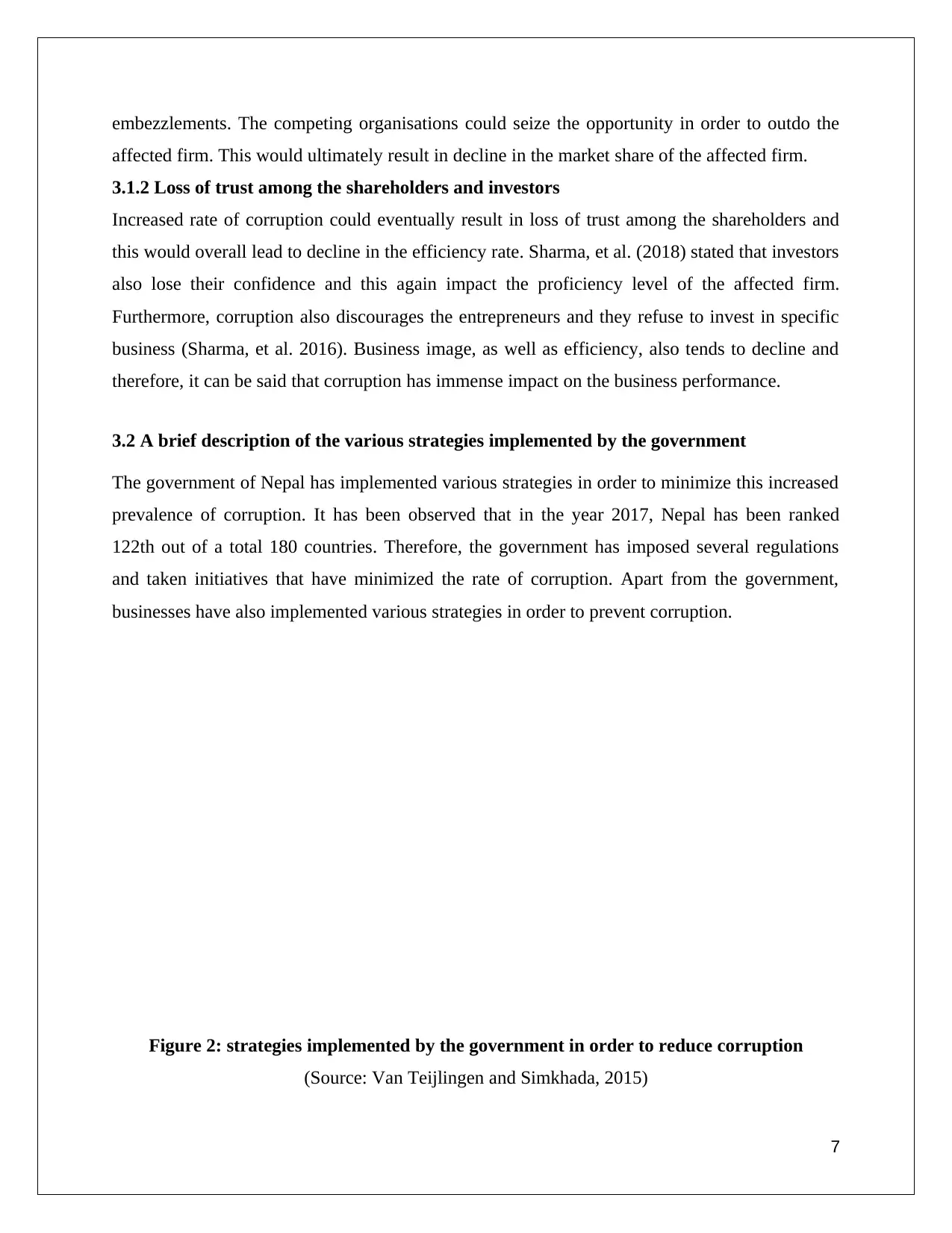
embezzlements. The competing organisations could seize the opportunity in order to outdo the
affected firm. This would ultimately result in decline in the market share of the affected firm.
3.1.2 Loss of trust among the shareholders and investors
Increased rate of corruption could eventually result in loss of trust among the shareholders and
this would overall lead to decline in the efficiency rate. Sharma, et al. (2018) stated that investors
also lose their confidence and this again impact the proficiency level of the affected firm.
Furthermore, corruption also discourages the entrepreneurs and they refuse to invest in specific
business (Sharma, et al. 2016). Business image, as well as efficiency, also tends to decline and
therefore, it can be said that corruption has immense impact on the business performance.
3.2 A brief description of the various strategies implemented by the government
The government of Nepal has implemented various strategies in order to minimize this increased
prevalence of corruption. It has been observed that in the year 2017, Nepal has been ranked
122th out of a total 180 countries. Therefore, the government has imposed several regulations
and taken initiatives that have minimized the rate of corruption. Apart from the government,
businesses have also implemented various strategies in order to prevent corruption.
Figure 2: strategies implemented by the government in order to reduce corruption
(Source: Van Teijlingen and Simkhada, 2015)
7
affected firm. This would ultimately result in decline in the market share of the affected firm.
3.1.2 Loss of trust among the shareholders and investors
Increased rate of corruption could eventually result in loss of trust among the shareholders and
this would overall lead to decline in the efficiency rate. Sharma, et al. (2018) stated that investors
also lose their confidence and this again impact the proficiency level of the affected firm.
Furthermore, corruption also discourages the entrepreneurs and they refuse to invest in specific
business (Sharma, et al. 2016). Business image, as well as efficiency, also tends to decline and
therefore, it can be said that corruption has immense impact on the business performance.
3.2 A brief description of the various strategies implemented by the government
The government of Nepal has implemented various strategies in order to minimize this increased
prevalence of corruption. It has been observed that in the year 2017, Nepal has been ranked
122th out of a total 180 countries. Therefore, the government has imposed several regulations
and taken initiatives that have minimized the rate of corruption. Apart from the government,
businesses have also implemented various strategies in order to prevent corruption.
Figure 2: strategies implemented by the government in order to reduce corruption
(Source: Van Teijlingen and Simkhada, 2015)
7
Paraphrase This Document
Need a fresh take? Get an instant paraphrase of this document with our AI Paraphraser
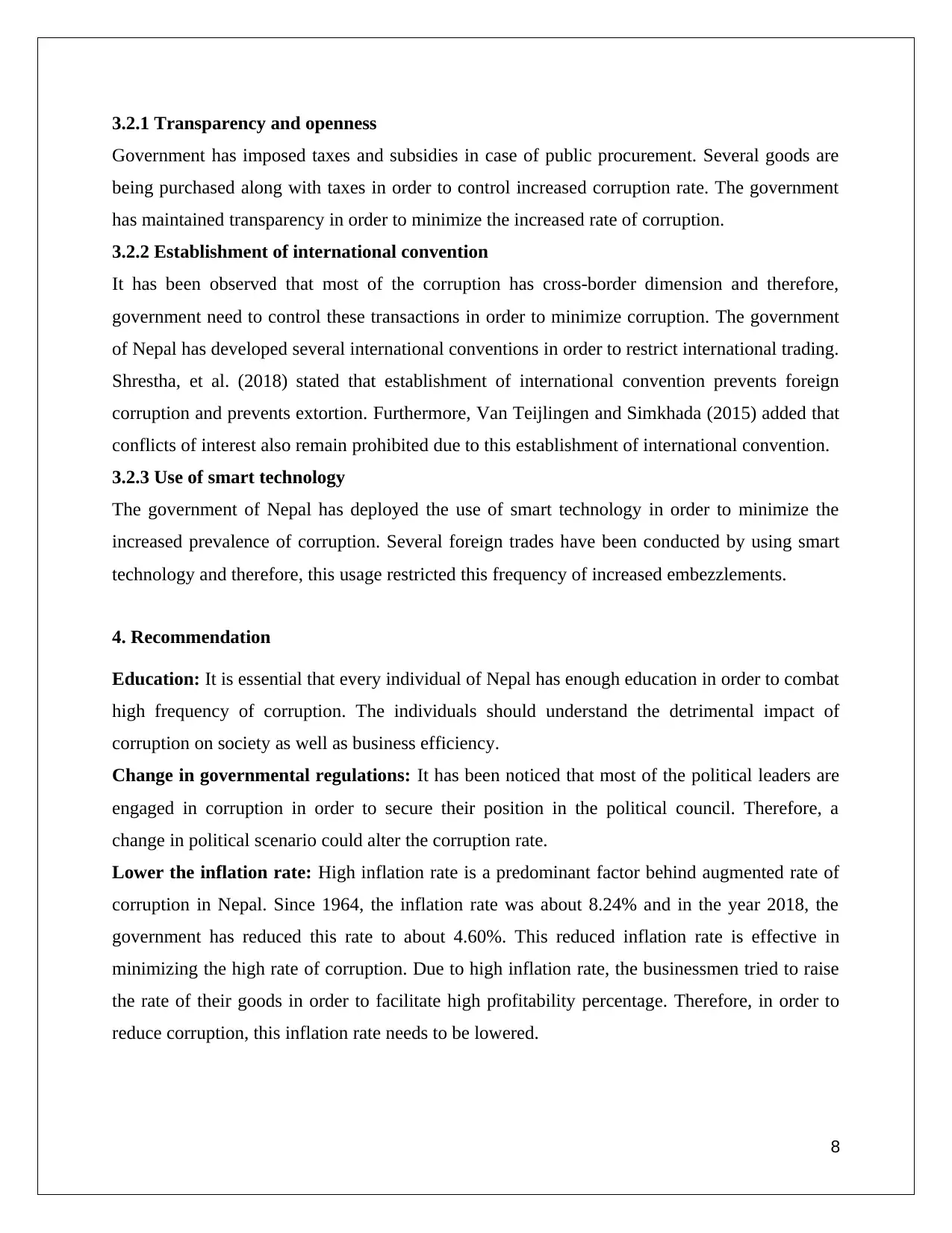
3.2.1 Transparency and openness
Government has imposed taxes and subsidies in case of public procurement. Several goods are
being purchased along with taxes in order to control increased corruption rate. The government
has maintained transparency in order to minimize the increased rate of corruption.
3.2.2 Establishment of international convention
It has been observed that most of the corruption has cross-border dimension and therefore,
government need to control these transactions in order to minimize corruption. The government
of Nepal has developed several international conventions in order to restrict international trading.
Shrestha, et al. (2018) stated that establishment of international convention prevents foreign
corruption and prevents extortion. Furthermore, Van Teijlingen and Simkhada (2015) added that
conflicts of interest also remain prohibited due to this establishment of international convention.
3.2.3 Use of smart technology
The government of Nepal has deployed the use of smart technology in order to minimize the
increased prevalence of corruption. Several foreign trades have been conducted by using smart
technology and therefore, this usage restricted this frequency of increased embezzlements.
4. Recommendation
Education: It is essential that every individual of Nepal has enough education in order to combat
high frequency of corruption. The individuals should understand the detrimental impact of
corruption on society as well as business efficiency.
Change in governmental regulations: It has been noticed that most of the political leaders are
engaged in corruption in order to secure their position in the political council. Therefore, a
change in political scenario could alter the corruption rate.
Lower the inflation rate: High inflation rate is a predominant factor behind augmented rate of
corruption in Nepal. Since 1964, the inflation rate was about 8.24% and in the year 2018, the
government has reduced this rate to about 4.60%. This reduced inflation rate is effective in
minimizing the high rate of corruption. Due to high inflation rate, the businessmen tried to raise
the rate of their goods in order to facilitate high profitability percentage. Therefore, in order to
reduce corruption, this inflation rate needs to be lowered.
8
Government has imposed taxes and subsidies in case of public procurement. Several goods are
being purchased along with taxes in order to control increased corruption rate. The government
has maintained transparency in order to minimize the increased rate of corruption.
3.2.2 Establishment of international convention
It has been observed that most of the corruption has cross-border dimension and therefore,
government need to control these transactions in order to minimize corruption. The government
of Nepal has developed several international conventions in order to restrict international trading.
Shrestha, et al. (2018) stated that establishment of international convention prevents foreign
corruption and prevents extortion. Furthermore, Van Teijlingen and Simkhada (2015) added that
conflicts of interest also remain prohibited due to this establishment of international convention.
3.2.3 Use of smart technology
The government of Nepal has deployed the use of smart technology in order to minimize the
increased prevalence of corruption. Several foreign trades have been conducted by using smart
technology and therefore, this usage restricted this frequency of increased embezzlements.
4. Recommendation
Education: It is essential that every individual of Nepal has enough education in order to combat
high frequency of corruption. The individuals should understand the detrimental impact of
corruption on society as well as business efficiency.
Change in governmental regulations: It has been noticed that most of the political leaders are
engaged in corruption in order to secure their position in the political council. Therefore, a
change in political scenario could alter the corruption rate.
Lower the inflation rate: High inflation rate is a predominant factor behind augmented rate of
corruption in Nepal. Since 1964, the inflation rate was about 8.24% and in the year 2018, the
government has reduced this rate to about 4.60%. This reduced inflation rate is effective in
minimizing the high rate of corruption. Due to high inflation rate, the businessmen tried to raise
the rate of their goods in order to facilitate high profitability percentage. Therefore, in order to
reduce corruption, this inflation rate needs to be lowered.
8
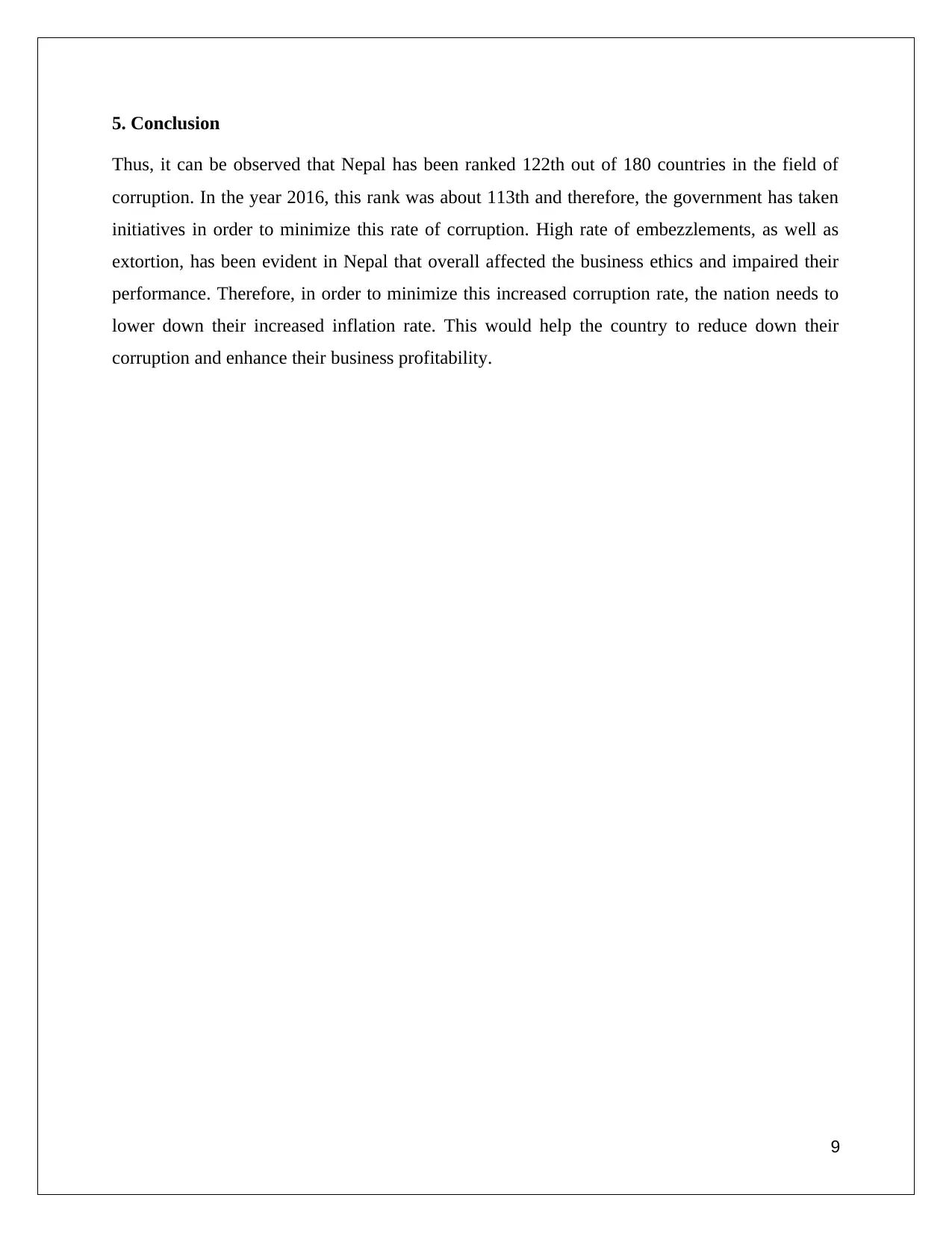
5. Conclusion
Thus, it can be observed that Nepal has been ranked 122th out of 180 countries in the field of
corruption. In the year 2016, this rank was about 113th and therefore, the government has taken
initiatives in order to minimize this rate of corruption. High rate of embezzlements, as well as
extortion, has been evident in Nepal that overall affected the business ethics and impaired their
performance. Therefore, in order to minimize this increased corruption rate, the nation needs to
lower down their increased inflation rate. This would help the country to reduce down their
corruption and enhance their business profitability.
9
Thus, it can be observed that Nepal has been ranked 122th out of 180 countries in the field of
corruption. In the year 2016, this rank was about 113th and therefore, the government has taken
initiatives in order to minimize this rate of corruption. High rate of embezzlements, as well as
extortion, has been evident in Nepal that overall affected the business ethics and impaired their
performance. Therefore, in order to minimize this increased corruption rate, the nation needs to
lower down their increased inflation rate. This would help the country to reduce down their
corruption and enhance their business profitability.
9
⊘ This is a preview!⊘
Do you want full access?
Subscribe today to unlock all pages.

Trusted by 1+ million students worldwide
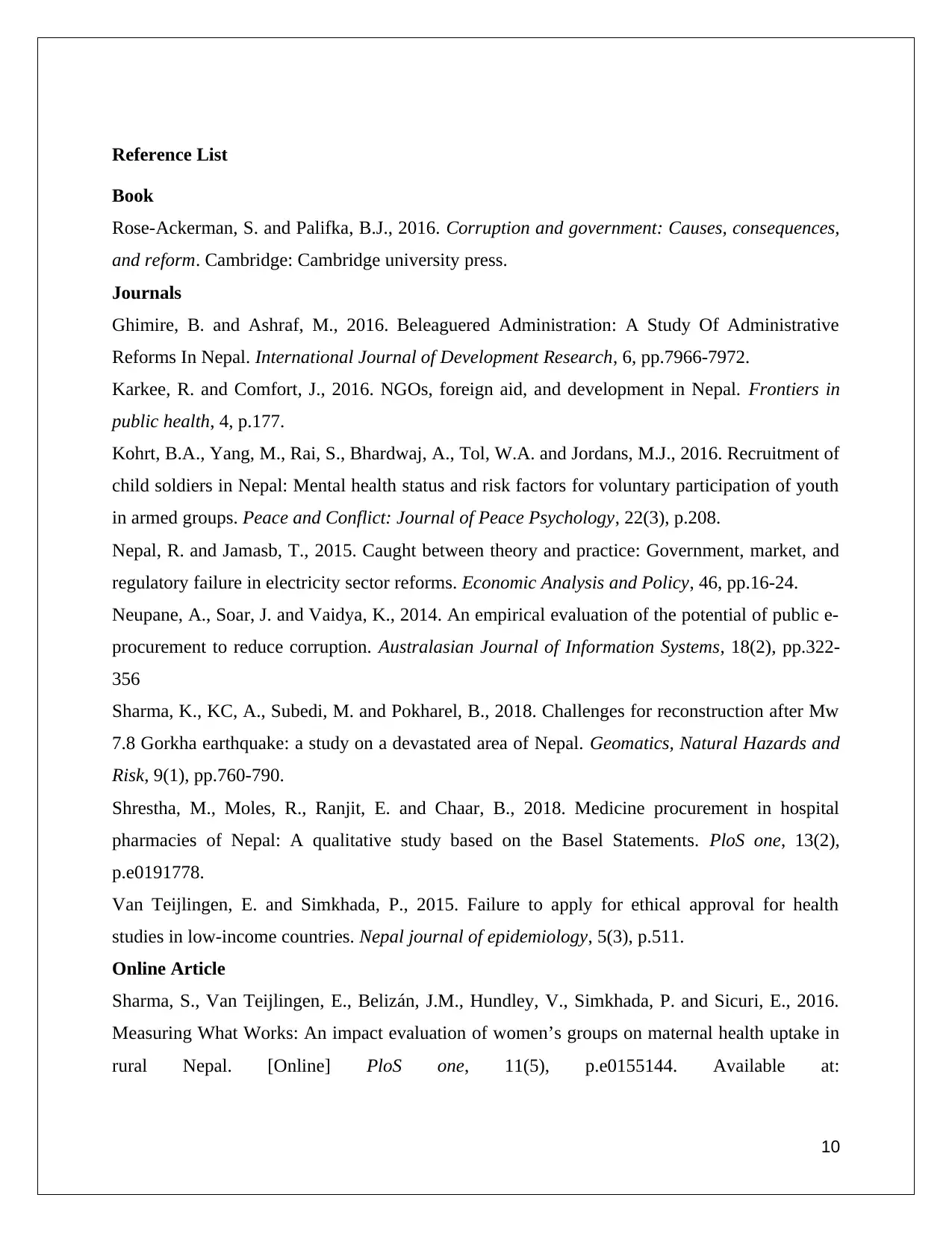
Reference List
Book
Rose-Ackerman, S. and Palifka, B.J., 2016. Corruption and government: Causes, consequences,
and reform. Cambridge: Cambridge university press.
Journals
Ghimire, B. and Ashraf, M., 2016. Beleaguered Administration: A Study Of Administrative
Reforms In Nepal. International Journal of Development Research, 6, pp.7966-7972.
Karkee, R. and Comfort, J., 2016. NGOs, foreign aid, and development in Nepal. Frontiers in
public health, 4, p.177.
Kohrt, B.A., Yang, M., Rai, S., Bhardwaj, A., Tol, W.A. and Jordans, M.J., 2016. Recruitment of
child soldiers in Nepal: Mental health status and risk factors for voluntary participation of youth
in armed groups. Peace and Conflict: Journal of Peace Psychology, 22(3), p.208.
Nepal, R. and Jamasb, T., 2015. Caught between theory and practice: Government, market, and
regulatory failure in electricity sector reforms. Economic Analysis and Policy, 46, pp.16-24.
Neupane, A., Soar, J. and Vaidya, K., 2014. An empirical evaluation of the potential of public e-
procurement to reduce corruption. Australasian Journal of Information Systems, 18(2), pp.322-
356
Sharma, K., KC, A., Subedi, M. and Pokharel, B., 2018. Challenges for reconstruction after Mw
7.8 Gorkha earthquake: a study on a devastated area of Nepal. Geomatics, Natural Hazards and
Risk, 9(1), pp.760-790.
Shrestha, M., Moles, R., Ranjit, E. and Chaar, B., 2018. Medicine procurement in hospital
pharmacies of Nepal: A qualitative study based on the Basel Statements. PloS one, 13(2),
p.e0191778.
Van Teijlingen, E. and Simkhada, P., 2015. Failure to apply for ethical approval for health
studies in low-income countries. Nepal journal of epidemiology, 5(3), p.511.
Online Article
Sharma, S., Van Teijlingen, E., Belizán, J.M., Hundley, V., Simkhada, P. and Sicuri, E., 2016.
Measuring What Works: An impact evaluation of women’s groups on maternal health uptake in
rural Nepal. [Online] PloS one, 11(5), p.e0155144. Available at:
10
Book
Rose-Ackerman, S. and Palifka, B.J., 2016. Corruption and government: Causes, consequences,
and reform. Cambridge: Cambridge university press.
Journals
Ghimire, B. and Ashraf, M., 2016. Beleaguered Administration: A Study Of Administrative
Reforms In Nepal. International Journal of Development Research, 6, pp.7966-7972.
Karkee, R. and Comfort, J., 2016. NGOs, foreign aid, and development in Nepal. Frontiers in
public health, 4, p.177.
Kohrt, B.A., Yang, M., Rai, S., Bhardwaj, A., Tol, W.A. and Jordans, M.J., 2016. Recruitment of
child soldiers in Nepal: Mental health status and risk factors for voluntary participation of youth
in armed groups. Peace and Conflict: Journal of Peace Psychology, 22(3), p.208.
Nepal, R. and Jamasb, T., 2015. Caught between theory and practice: Government, market, and
regulatory failure in electricity sector reforms. Economic Analysis and Policy, 46, pp.16-24.
Neupane, A., Soar, J. and Vaidya, K., 2014. An empirical evaluation of the potential of public e-
procurement to reduce corruption. Australasian Journal of Information Systems, 18(2), pp.322-
356
Sharma, K., KC, A., Subedi, M. and Pokharel, B., 2018. Challenges for reconstruction after Mw
7.8 Gorkha earthquake: a study on a devastated area of Nepal. Geomatics, Natural Hazards and
Risk, 9(1), pp.760-790.
Shrestha, M., Moles, R., Ranjit, E. and Chaar, B., 2018. Medicine procurement in hospital
pharmacies of Nepal: A qualitative study based on the Basel Statements. PloS one, 13(2),
p.e0191778.
Van Teijlingen, E. and Simkhada, P., 2015. Failure to apply for ethical approval for health
studies in low-income countries. Nepal journal of epidemiology, 5(3), p.511.
Online Article
Sharma, S., Van Teijlingen, E., Belizán, J.M., Hundley, V., Simkhada, P. and Sicuri, E., 2016.
Measuring What Works: An impact evaluation of women’s groups on maternal health uptake in
rural Nepal. [Online] PloS one, 11(5), p.e0155144. Available at:
10
Paraphrase This Document
Need a fresh take? Get an instant paraphrase of this document with our AI Paraphraser
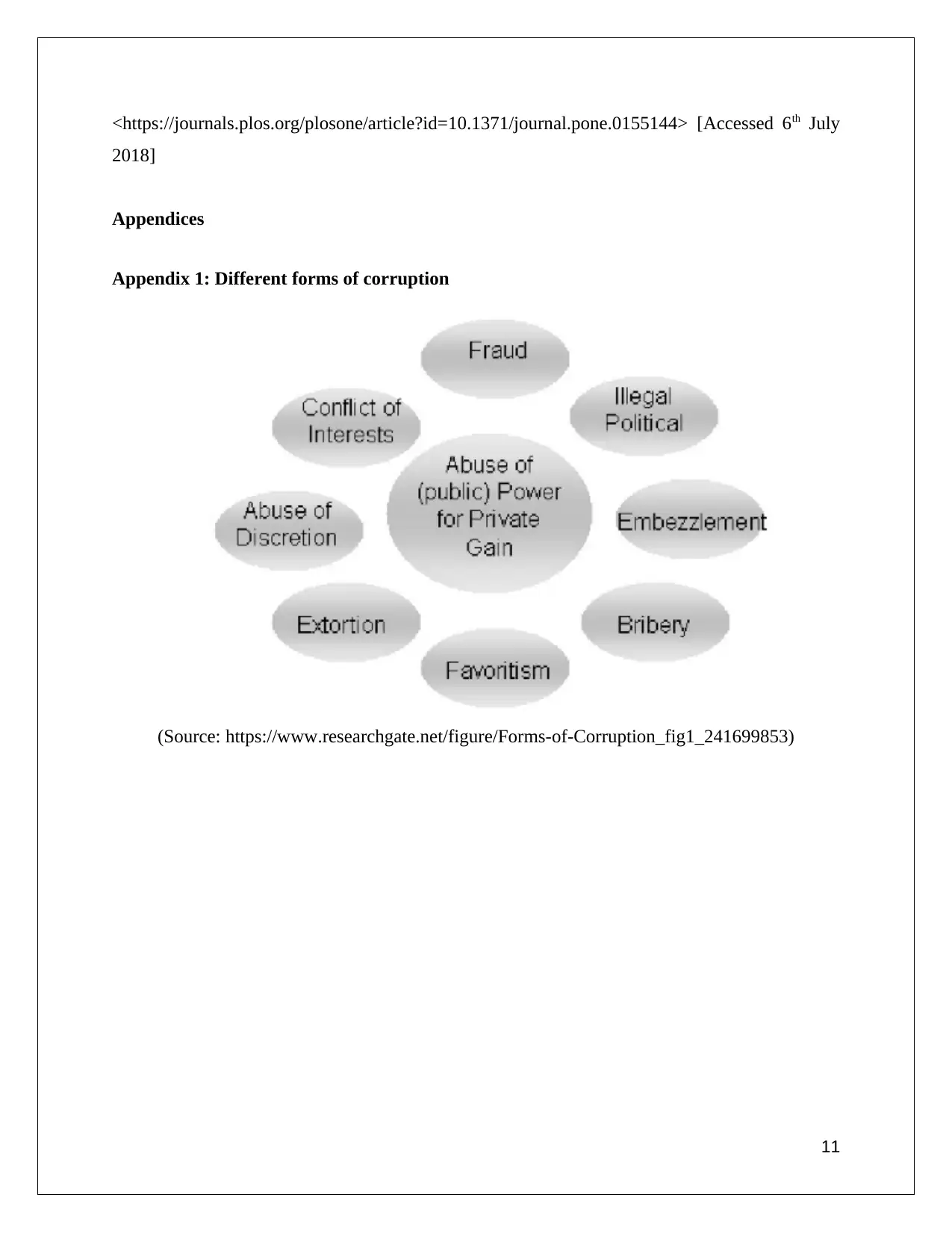
<https://journals.plos.org/plosone/article?id=10.1371/journal.pone.0155144> [Accessed 6th July
2018]
Appendices
Appendix 1: Different forms of corruption
(Source: https://www.researchgate.net/figure/Forms-of-Corruption_fig1_241699853)
11
2018]
Appendices
Appendix 1: Different forms of corruption
(Source: https://www.researchgate.net/figure/Forms-of-Corruption_fig1_241699853)
11
1 out of 11
Related Documents
Your All-in-One AI-Powered Toolkit for Academic Success.
+13062052269
info@desklib.com
Available 24*7 on WhatsApp / Email
![[object Object]](/_next/static/media/star-bottom.7253800d.svg)
Unlock your academic potential
Copyright © 2020–2025 A2Z Services. All Rights Reserved. Developed and managed by ZUCOL.





